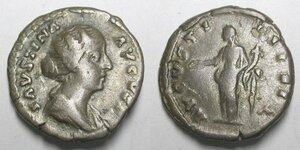Volos
Jr. Member
The coin was found in Moldova (http://en.wikipedia.org/wiki/Moldova) by my colleague, accompanied by several other silvers of Hadrian, Markus Aurelius and a Faustina II's sestertius. Could anyone help with its attribution, please? With catalogue references and desirably with examples? I cannot read the legend either. Could it be a barbarian immitation?
2,74 g
1,8 cm
The pic is the only one available

Thank you!
2,74 g
1,8 cm
The pic is the only one available


Thank you!





 ) of what is now known as a Chernyakhovskaya archaeological culture (covered modern Ukraine, Moldova and Romania in the 2nd through 4th centuries AD; commonly called by historians as Goths). As a prototype to this coin there might'd been taken this issue of Antoninus Pius with Pax on the reverse (RIC153):
) of what is now known as a Chernyakhovskaya archaeological culture (covered modern Ukraine, Moldova and Romania in the 2nd through 4th centuries AD; commonly called by historians as Goths). As a prototype to this coin there might'd been taken this issue of Antoninus Pius with Pax on the reverse (RIC153): 








 Volos...
Volos...

